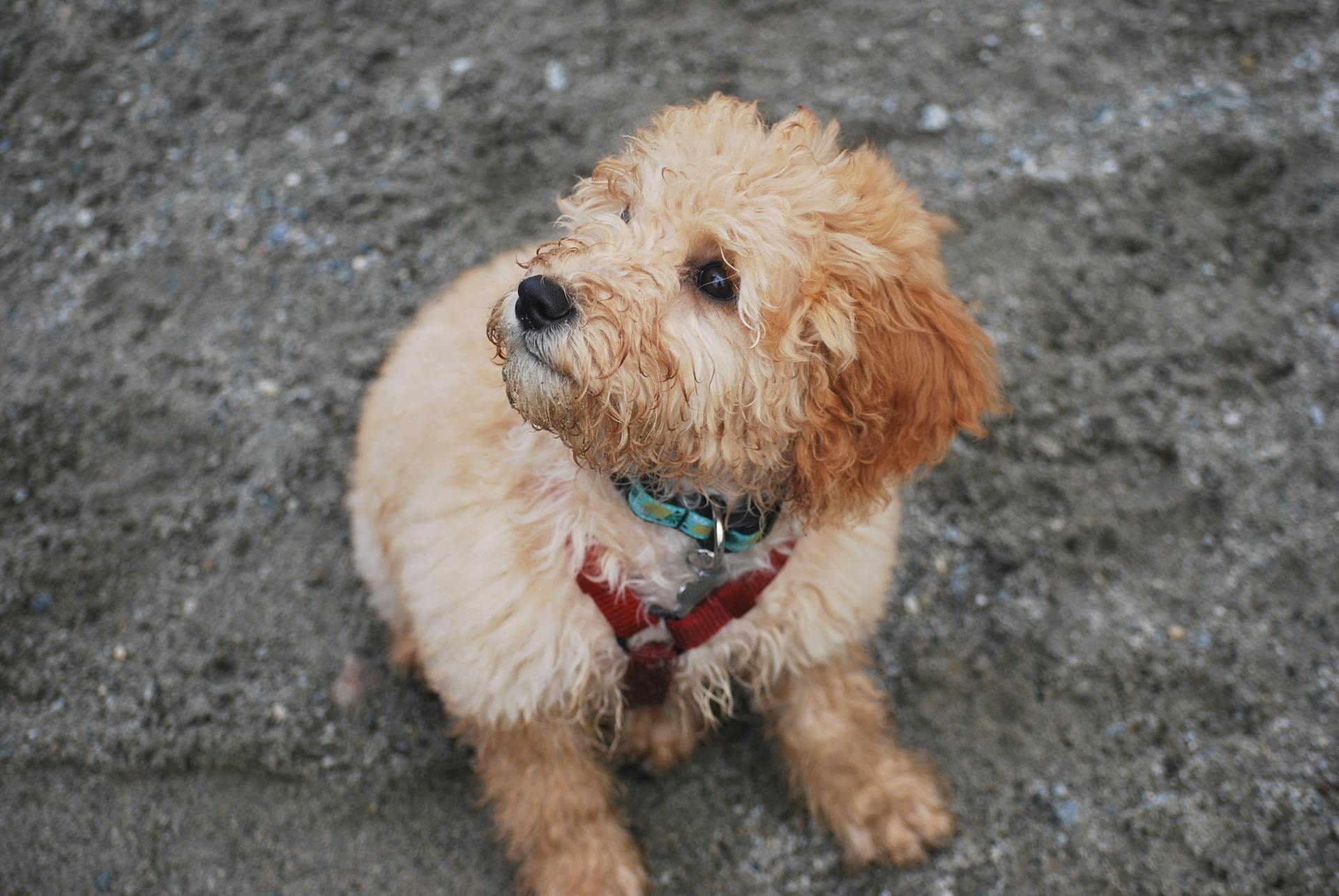
The Australian Shepherd dog is a beloved breed known for its striking coat colors. These colors can vary from a classic blue merle to a rare red merle.
One of the most distinctive features of the Australian Shepherd is its merle pattern, which is caused by a genetic variation that creates a mottled effect on the dog's coat. This pattern can appear in a variety of colors, including blue, red, and black.
In addition to merle patterns, Australian Shepherds can also have a solid coat color, such as black or blue. These solid colors are the result of a dominant gene that suppresses the merle pattern.
Standard Colors
The Australian Shepherd is a breed that comes in a variety of beautiful colors.
The breed standard includes all physical traits, including coat colors that dogs should come in.
You can find Australian Shepherds in standard colors such as black, blue merle, red merle, and red.

The standard colors of the Australian Shepherd are determined by the breed standard, which is a set of guidelines that define the breed's physical characteristics.
The standard colors of the breed include blue merle, which is a mix of gray and black colors.
Australian Shepherds can also come in red, which is a solid coat color.
Non-Standard Colors
Non-standard Australian Shepherd Colors can be a bit tricky to navigate. Most of the time, these colors are an indication that the dog isn't purebred.
Different kennel clubs have slightly different breed standards, but all major clubs agree on one thing: certain coat shades are faulty. The AKC, UKC, and FCI all share this opinion.
Tan
Tan markings on Australian Shepherds are a distinctive feature of the breed. They're predominantly black with tan markings over their face, chest, and paws.
Black and tan bicolor Australian Shepherds are quite rare, making them quite expensive. This is due to their unique coloring.
Their shading closely resembles the most popular Doberman coloring. This is why many people consider them to be one of many Doberman mixes.
The tan markings on black and tan Australian Shepherds are usually found above their eyebrows, on their cheeks, and lower legs paws.
A different take: Rhodesian Ridgeback vs Doberman
Brindle
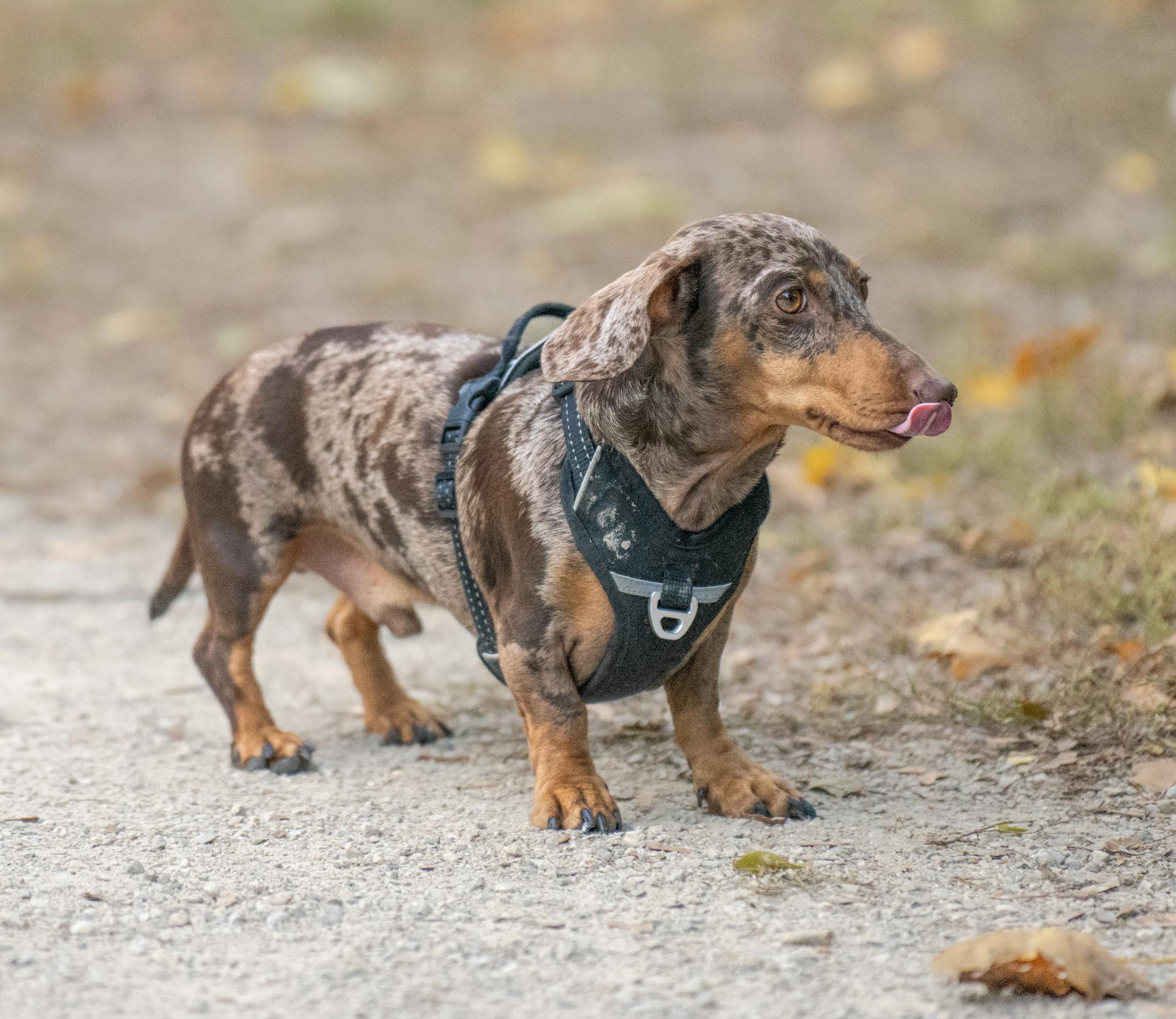
Brindle is a rare pattern in Australian Shepherds, causing tiger-like stripes on a brown base coat color. It's extremely uncommon in the breed, making it a telltale sign of a mixed breed dog.
If you spot a brindle Australian Shepherd, it's likely that the breeder is not reputable, as no good breeder would intentionally breed or advertise a brindle Aussie.
Brindle Aussies might initially blend in with white Aussies, but a closer look reveals some distinct differences.
Fawn
Fawn Australian Shepherds are the result of mixing brown and red genes with a dilution gene, which dilutes the red shade to a fawn hue.
These dogs aren't known to be any more sickly than dogs in standard colors, so you don't have to worry about their health.
The dilution gene is considered undesirable, which is why fawn and white Aussies aren't allowed to breed.
This means they aren't recognized by the AKC, so if you're looking for a purebred Aussie, you'll want to stick with standard colors.
Worth a look: Amstaff Fawn
Bicolor

Bicolor Australian Shepherds have two main color combinations: black tri and red bicolor. The black tri is the most common color, featuring a predominantly black coat with white markings and tan points.
Red bicolor Aussies have a red coat with white markings over their face, chest, and legs. The red part of the coat can vary from bright cinnamon to dark liver, contrasting beautifully with their white markings.
One distinctive feature of red bicolor Aussies is the white markings on their chest, which can extend around their neck like a collar. This creates a unique and striking appearance.
Red bicolor Aussies cannot have tan markings without white ones, making their color combination quite distinct.
For your interest: Tri Color English Springer Spaniel
Color Patterns
Australian Shepherds can display a range of coat patterns, each adding its unique touch to the dog's appearance.
The classic merle pattern is a marbling effect created by patches or spots of color on a lighter background.
Other notable patterns include brindle, speckled, and parti-color, which offer a variety of visual interest to the breed.
These patterns can vary in intensity and distribution, resulting in a unique look for each individual dog.
Merle
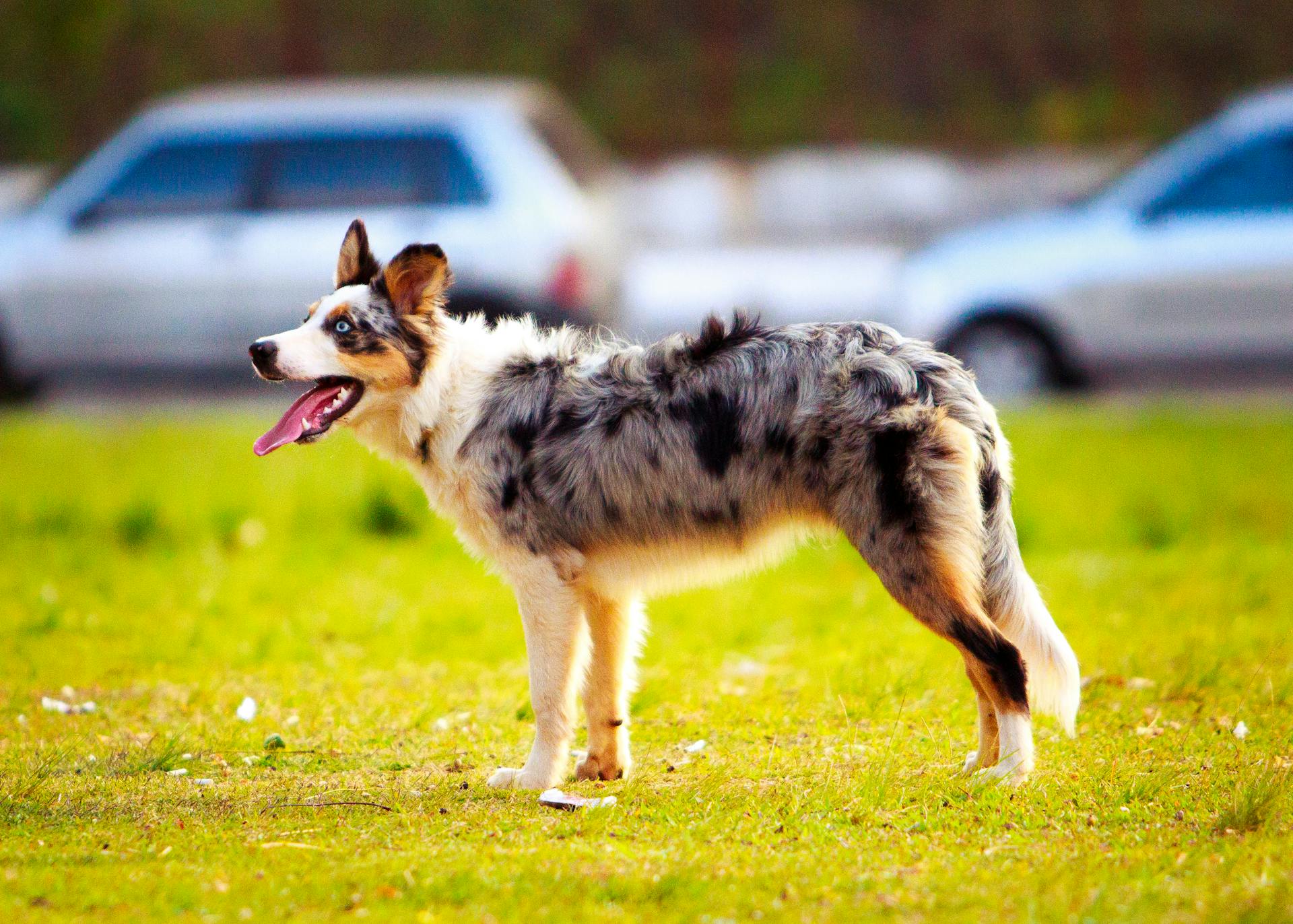
Merle is a unique and striking coat pattern found in Australian Shepherds. It's created by patches or spots of color on a lighter background.
The classic merle pattern is one of the most recognizable, but there are also variations like brindle and speckled. Each adds its own touch to the dog's appearance.
Red merle Australian Shepherds are a variation of the merle pattern, with three different types: solid red merle, red merle bicolor, and red merle tricolor. They often have unique eyes, too.
Red merles can have solid amber or blue eyes, but sometimes their blue eyes contain brown spots, or if they have brown eyes, they might have blue spots – this is known as marbling or flecking.
Blue merle Australian Shepherds are identified by their coat pattern, which features a mix of gray, black, and white, giving the coat a bluish cast. This merle pattern creates a mottled effect that can also include various shades of gray interspersed with black.
Each blue merle Aussie is unique, with no two coats being exactly alike due to the random distribution of the merle gene.
For your interest: Boston Terrier Spots
Tri

The tri color pattern is a classic look in Australian Shepherds, and it's easy to see why it's so popular.
The most common tri color is the black tri, which features a predominantly black coat with white markings and tan points.
This color combination provides a striking contrast and distinctive appearance that adheres closely to the breed's standard in show rings.
In fact, the black tri is the most common color of Australian Shepherds, making it a great choice for first-time owners or those who want a classic look.
Red tris are another variation of the tri color pattern, where the base color is red instead of black, complemented by white and tan markings.
Red tris are admired for their stunning contrast and depth of color, with the red providing a vivid backdrop for the white and tan markings.
The genetic basis of coat color in Australian Shepherds is primarily determined by genetic factors, with genes controlling the production and distribution of pigments that contribute to the coloration of the coat.
Specifically, genes control the production of eumelanin (black or brown pigment) and pheomelanin (red or yellow pigment), which are responsible for the different hues observed in Australian Shepherds.
This means that the tri color pattern is a result of a specific combination of genes, making each individual dog unique.
A unique perspective: Tri Color Yorkshire Terrier
Unraveling the Rainbow
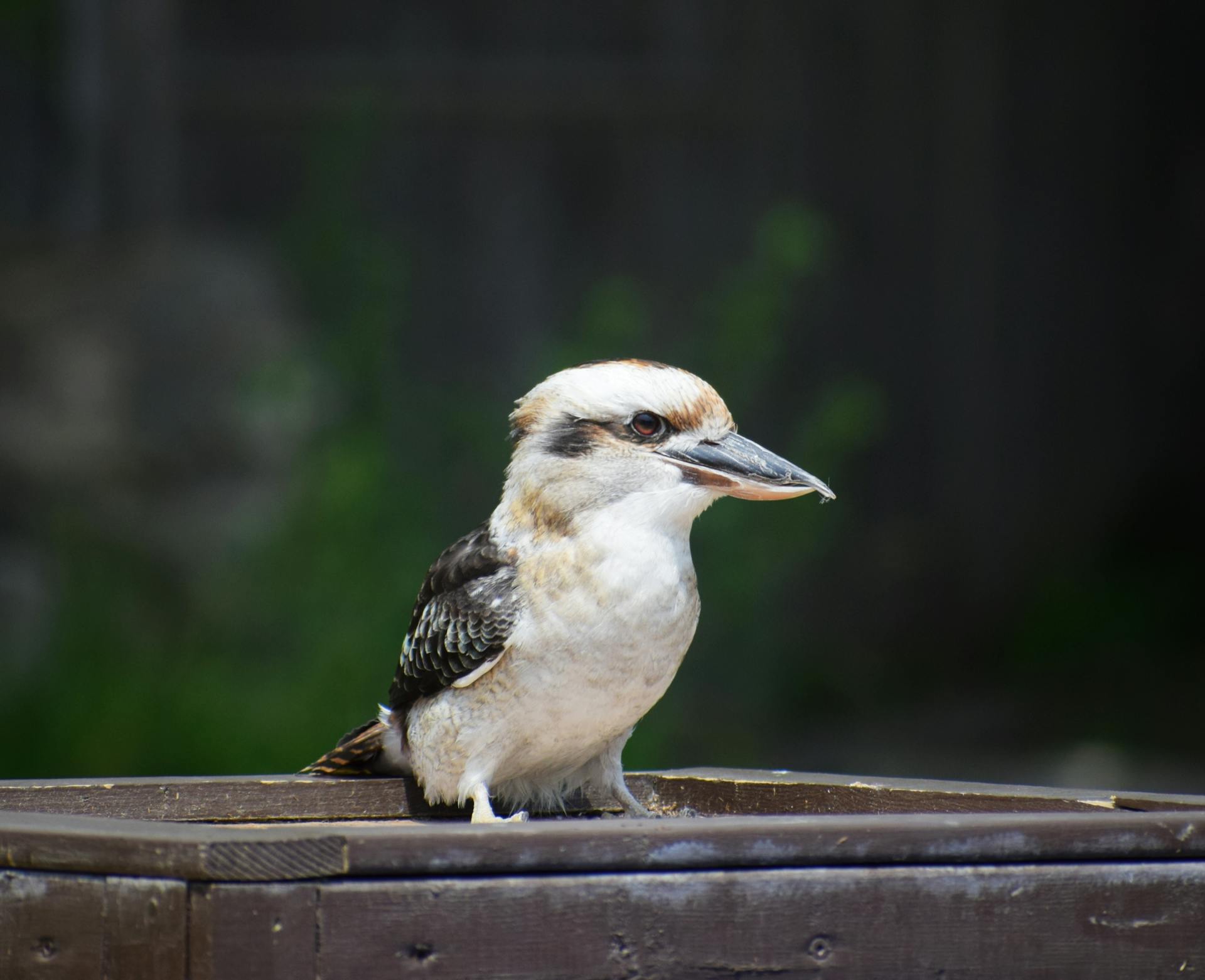
The Australian Shepherd's coat is a true marvel, with a wide range of colors and patterns that make each dog unique. The most common color of Australian Shepherds is the black tri, featuring a predominantly black coat with white markings and tan points.
Genes play a crucial role in determining the color of an Australian Shepherd's coat. Coat color in Australian Shepherds is primarily determined by genetic factors, with specific genes controlling the production and distribution of pigments that contribute to the coloration of the coat.
The black tri color combination provides a classic look that is both bold and beautiful, making it highly favored among Aussie enthusiasts. This striking contrast and distinctive appearance adhere closely to the breed's standard in show rings.
The blue merle pattern creates a mottled effect that can also include various shades of gray interspersed with black, giving the coat a bluish cast. Blue merle Aussies often have blue or partially blue eyes, which further enhances their striking appearance.
Each blue merle Aussie is unique, with no two coats being exactly alike due to the random distribution of the merle gene. The merle pattern is a result of the interaction between different genes, which is what makes each blue merle Aussie's coat so unique.
Suggestion: Tri Color Pembroke Welsh Corgi
Color FAQs

The Australian Shepherd dog comes in a variety of colors, but did you know that the breed standard only recognizes three main colors: blue merle, black, and red?
Blue merle Australian Shepherds have a distinctive mottled gray and black coat, with a mix of blue and black patches.
Blue merle dogs can have a range of eye colors, including blue, brown, or one blue and one brown eye.
Black Australian Shepherds have a solid black coat, with no white markings.
Red Australian Shepherds have a solid red coat, with no white markings.
White markings can occur on the chest, paws, and face of Australian Shepherds, but they must be minimal to meet the breed standard.
Australian Shepherds can also have a small amount of tan or gold on their face, legs, and chest, but this must be minimal to meet the breed standard.
If this caught your attention, see: Amber Dog Eye Colors
Health Problems
Merle Australian Shepherds can be more prone to certain health issues due to the genetic complexity associated with the merle coloration.
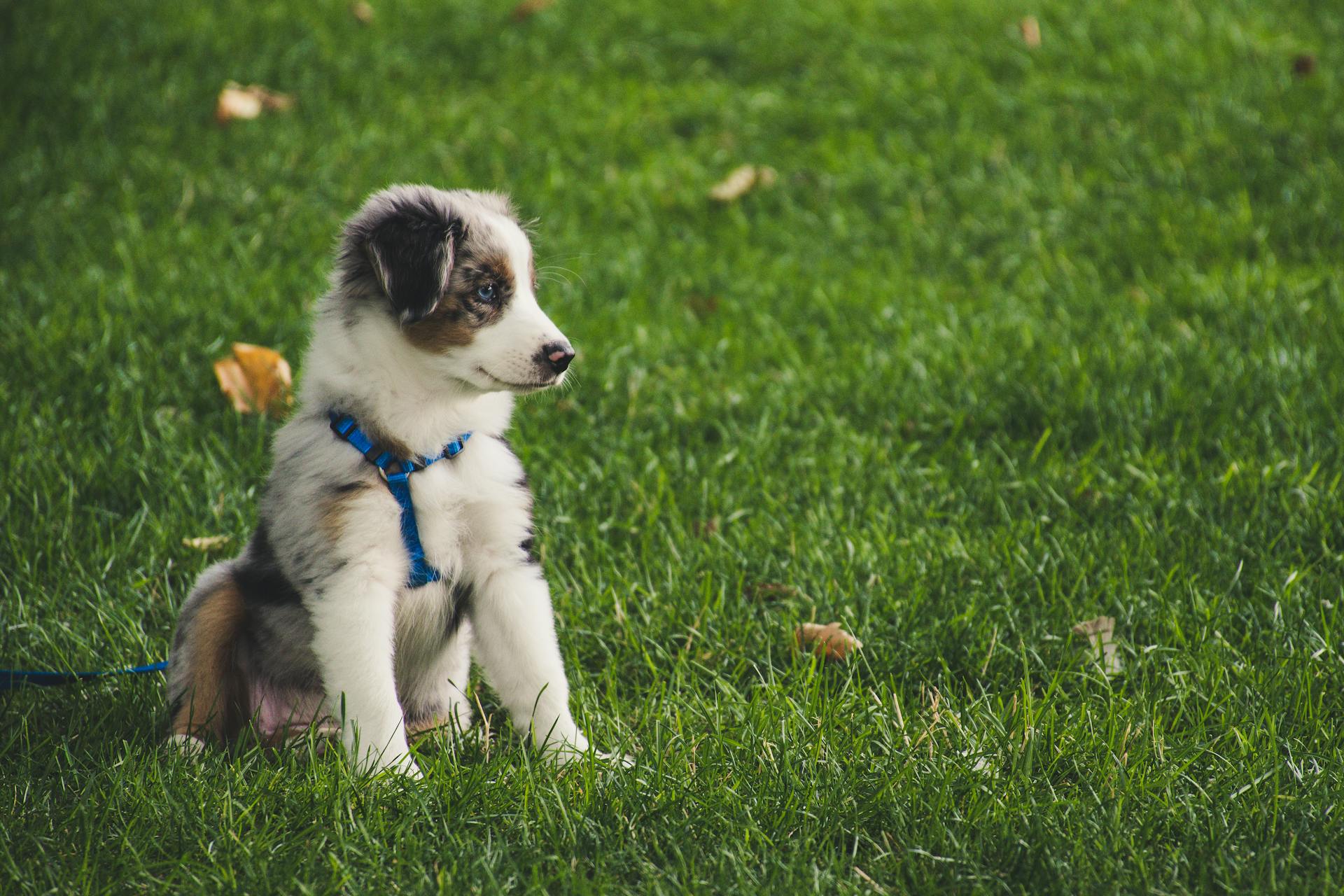
Double-merle offspring, resulting from breeding two merle-colored parents, are particularly at risk for deafness and blindness.
Merle Aussies may also experience auditory and visual impairments, making responsible breeding practices crucial to minimize health risks related to their distinctive coat pattern.
Prospective owners should work with reputable breeders who avoid pairing two merle Aussies to ensure the health and well-being of their puppies.
Readers also liked: Pembroke Welsh Corgi Health
Dogs and Pink Noses
Australian Shepherds typically have black or liver-colored noses, depending on their coat color.
A pink nose in an Aussie is not standard and can be a sign of the "lethal white" syndrome, associated with double merles.
This genetic trait is linked to a lack of pigment in the dog's coat.
Some Aussies may have lighter or partially pink noses due to less pigment, which is not necessarily a health concern unless accompanied by other symptoms of albinism or poor pigmentation.
In such cases, a pink nose can be a warning sign for underlying health issues.
Additional reading: Rhodesian Ridgeback Health Issues
Genetics and Color

The genetics behind Australian Shepherd coat colors is a fascinating topic. Coat color in Australian Shepherds is primarily determined by genetic factors.
Genetic principles govern the production and distribution of pigments that contribute to the coloration of the coat. Specific genes control the production of eumelanin (black or brown pigment) and pheomelanin (red or yellow pigment).
The Agouti gene (ASIP) plays a crucial role in determining the distribution of eumelanin and pheomelanin on the coat. Variations in this gene lead to different coat patterns, such as solid colors, banded hairs, or the marbled effect seen in merle patterns.
Dilution genes affect the intensity and saturation of coat colors in Australian Shepherds. The D locus, for instance, controls the dilution of eumelanin, resulting in lighter shades of coat colors such as Solid Blue or Solid Red.
The Merle gene (M) is responsible for the marbled or mottled coat pattern seen in Australian Shepherds with Blue Merle or Red Merle coats. This gene affects the distribution and density of pigments, resulting in patches or streaks of color on a lighter base.
Understanding the genetic principles that govern coat colors can deepen our appreciation for the breed and shed light on how these traits are inherited.
Color Dilution
Color dilution is a factor that can influence coat color in Australian Shepherds, affecting the intensity and saturation of coat colors.
The presence of dilution genes can result in lighter shades of coat colors or the appearance of diluted coat patterns, such as a washed-out or faded look.
Dilution genes can be responsible for coat variations like Solid Blue or Solid Red.
These variations can give Australian Shepherds a unique and distinctive appearance, making each dog's coat truly one-of-a-kind.
Dilution genes work by affecting the production of pigments in the coat, resulting in lighter or more washed-out colors.
This means that dogs with dilution genes may have a coat that appears lighter or more faded than dogs without these genes.
The combination of genetic factors, including dilution genes, is what creates the incredible diversity of coat colors seen in Australian Shepherds.
Frequently Asked Questions
What is the rarest Australian Shepherd color?
The rarest Australian Shepherd color is solid red. This unique color makes them highly sought after by breed enthusiasts.
What are the two types of Australian Shepherds?
Australian Shepherds come in two main coat types: solid and merle, with solid coats featuring a single color and merle coats showcasing a marbled pattern of colors. The solid colors include black, blue merle, red, and red merle.
What is an Aussie tri?
An Aussie tri refers to a dog with a base color of black or red, combined with a second color of white or copper, resulting in a three-color coat pattern. This distinctive pattern is a result of the Irish spotting pattern.
Sources
- https://www.dogster.com/lifestyle/australian-shepherd-colors
- https://breedatlas.net/australian-shepherd-colors/
- https://iheartdogs.com/australian-shepherd-colors-stunning-variations-with-pictures/
- https://www.paintedblueaussies.com/australian-shepherd-colors
- https://blog.tryfi.com/australian-shepherd-colors/
Featured Images: pexels.com
